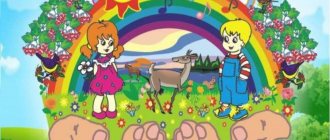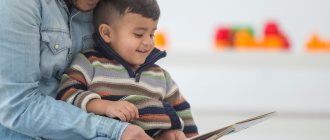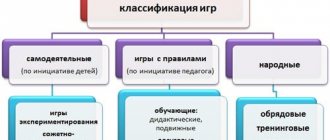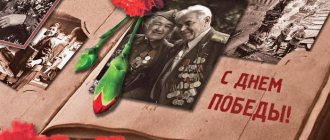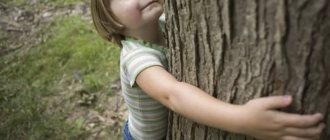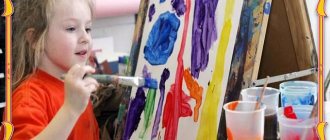“Forms and methods of patriotic education of preschool children.”
Yulia Gladkikh
“Forms and methods of patriotic education of preschool children.”
Patriotic education of children is one of the main tasks of a preschool educational institution.
Patriotic education is a purposeful process of influencing an individual with the goal of developing patriotism , as a quality manifested in love for one’s Fatherland and service to it.
Cultivating a sense of patriotism in preschoolers is a complex and lengthy process, requiring great personal conviction and inspiration from the teacher. This very painstaking work must be carried out systematically, systematically, in all age groups, in different types of activities and in different directions: nurturing love for loved ones , for kindergarten, for one’s hometown, for one’s country.
Thus, in order to cultivate a sense of patriotism in preschoolers , teachers must use various forms and methods of organizing children's activities. In their work, teachers can use the following methods :
1. Targeted walks, excursions to places of military glory, to monuments, to the local history museum, etc.;
2. Stories from the teacher , conversations with children about the glorious history of their native country and native city;
3. Observations (for example, allowing to see the working life of citizens, changes in the appearance of the city, district, street, new buildings being erected, etc.);
4. Demonstration of thematic slides, videos, illustrations;
5. Acquaintance with Russian folklore - fairy tales, proverbs, sayings, songs, games;
6. Acquaintance with folk art, embroidery, painting;
7. Acquaintance with the work of domestic writers, composers and artists;
8. Visiting thematic exhibitions or organizing them independently;
9. Participation in feasible socially useful work (work on the kindergarten site, joint work with parents to improve the territory of the kindergarten, etc.);
10. Personal example of a teacher who loves his job, his street, his city and takes an active part in public life (it is important to remember that the teacher’s worldview, his views, judgments, active life position are the most powerful factor in education ).
Of great importance in patriotic education is the active, varied activities of preschoolers , since being a patriot means not only knowing and loving your country, but also actively working for its benefit. To do this, use various forms of work :
1. targeted walks, excursions;
2. conversations;
3. games;
4. reading fiction;
5. holidays, entertainment, leisure evenings, quizzes;
6. and, of course, the main form of work is direct educational activity (various kinds of educational activities, studying state symbols of the Russian Federation, children gaining knowledge about the location, climate of their hometown, its history).
Interaction with parents. Holding exhibitions of crafts and drawings with their participation on the theme “My Family”
,
“My mother is the best,”
etc., improvement of preschool educational institutions, holding competitions, holidays and matinees, joint work on the site.
Contact with parents and family is of great importance in solving the problems of moral and patriotic education .
GCD is held once or twice a month, depending on the age group. The knowledge acquired during educational activities is consolidated in various forms outside the GCD . And throughout the year, the teacher returns several times to what the children learned earlier. Some topics are repeated in each age group, but with a certain complication (for example: “Defender of the Fatherland Day”
,
“Cosmonautics Day”
,
“Victory Day”
). Educational activities should be carried out using visual material.
When introducing preschoolers to the history of their hometown and their home country, the teacher has to tell them a lot, so when composing the story, the teacher must remember the following:
• During the story, it is necessary to use visual material. These can be photographs, reproductions of paintings, slides, various diagrams, chalk drawings on a blackboard, etc.
• When composing a story, the teacher must include questions for the children. This is necessary to activate cognitive activity, attention, arouse the interest of children, teach them to assume and reason. In this case, the teacher’s turns from a monologue into a kind of conversation with children, which contributes to more successful learning.
• When talking about some historical events, the teacher should not often use dates, since chronology is not available to children at preschool age. But in order for children to understand that the events described took place a long time ago, the following expressions should be used: “It was a very, very long time ago.”
,
“This was when your dads and moms were little
,” etc. Some dates should be communicated to children without requiring them to be memorized
(for example: 1941, 1945, April 12, 1961, etc.)
• The language of the story should be very simple. If the story contains words unfamiliar to children, for example: “prince”
,
“commander”
, their meaning should be explained. Do not overload the story with complex grammatical structures.
In the process of introducing children to the sights of their hometown, the teacher often tells them about various architectural structures, temples, and cathedrals. In this case, you should not consider their architecture in detail or use special terminology. It is enough to highlight something important that distinguishes this or that building from others.
When working with children to get to know their hometown, it is necessary to use such a form of work as targeted walks and excursions, since it is impossible to get to know and love a city only from illustrations. Children should know the area in which they live, see the beauty of the streets they pass through every day. But it should be remembered that you should go on targeted walks and excursions outside the preschool institution with the permission of the administration and accompanied by 2-3 adults.
Conversation is a method of persuasion . Its tasks are: the formation of civil and patriotic ideas of children ; explanation of norms and rules of behavior in society, nature, rules of communication; discussion and analysis of the actions of the children of the group, the life of the group.
Most often, the material for conversations is facts from the life of the group, works of fiction, publications in children's newspapers and magazines; current events in the group, questions and problems that concern children.
In order for the conversation to achieve its goals and objectives, the following requirements must be met:
• Formation of views occurs best through dialogue;
• The content of the conversation should correspond to the age of the children and their level of preparedness;
• Taking into account the age characteristics of children (emotionality, visual-figurative thinking, etc., it is necessary to conduct a conversation in simple, accessible language using clear, convincing facts and examples;
• The conversation should be problematic in nature, to resolve life problems that arise in the classroom;
• Conducting a conversation, the teacher relies on the life experience of the children, on their relationships;
• The success of the conversation depends on the activity of children, which can be caused by problematic questions, appeal to their life and moral experience, and well-chosen illustrative material. It is advisable to involve children in searching for material for conversation;
• Maintain the inviolability of the child’s personality, the friendliness, and tact of the teacher ;
• The children themselves must draw conclusions at the end of the conversation.
Topics of conversation:
“Preserve the beauty and richness of nature - this is our common home”
“Me and my small Motherland”
,
“Who do we call good?”
, “What is
a “beautiful deed”
?”,
“One’s own land is sweet in a handful”
,
“What does it mean to be
a patriot ?” ,
“Let there always be a mother”
,
“Everything in the world was created by labor”
, etc.
A holiday is a special form of educational work . Its distinctive features are that, firstly, it is based on joy and positive emotions. Secondly, it is distinguished by the diversity of children’s activities and the unity of various areas of educational work . Thirdly, a holiday, as a rule, requires careful preparation, since it involves organized actions of its participants according to a certain, pre-developed scenario.
In our work, we use holidays as a means of uniting children, allowing them to develop social and value-based relationships with each other, the school, and the people around them. Holidays give adults and children the joy of communication, cause shared experiences, and give everyone the opportunity to feel their unity with a group, school, city, country.
In our opinion, the effectiveness of holidays depends on compliance with the following pedagogical conditions:
• Children should actively participate in all stages of organizing the holiday (from planning to analyzing the results)
;
• It is necessary to involve parents in planning, choosing a plot, drawing up a script, and in external design ;
• All children should have the opportunity to demonstrate their talents and abilities;
• When developing a holiday, you should not use ready-made scenarios so that adults and children can show their own creative abilities;
• In order for everyone to find a place at the holiday, it is necessary to provide a variety of activities (games, singing, dancing, dramatization, music, poetry reading, etc.)
;
• Serious material support ( design , costumes, musical recordings, theatrical props, reproductions of paintings, etc.).
Games are the most important sphere of a child’s life and an effective method of education . It satisfies the child’s needs for activity, communication, emotional saturation, and self-realization.
the civic-patriotic education of preschoolers without game design and game elements. Therefore, we use the game to cultivate in children a value-based attitude towards their country, its history and culture, its people, its traditions, customs, art, etc.
In the process of civic and patriotic education we use a variety of games: educational, active, board, social and pedagogical, etc.
Using the proposed forms and methods of patriotic education , you will achieve success. You will show children the beauty of your hometown, introduce them to the talent of the Russian people, some heroic pages of history, teach children to love their city and their country, and be proud that they live in such a beautiful country as Russia.
MAGAZINE Preschooler.RF
“Methods of patriotic education of preschool children”article prepared by: senior teacher Sitnyanskaya L.A.
Educational methods are socially determined ways and means of pedagogically appropriate interaction between adults and children, facilitating the organization of children's life, activities, relationships, communication, stimulating their activity and regulating behavior. With the help of education methods, children’s behavior is corrected, personality traits are formed, and the experience of their activities, communication and relationships is enriched.
In pedagogy, there are many approaches to the classification of educational methods. We have chosen a classification of methods based on an activity-based approach to the education process.
The choice of methods of patriotic education depends on:
- on the purpose of education;
- leading type of activity;
- content and patterns of education;
- specific tasks and conditions for their solution;
- age, individual and gender characteristics of pupils; good manners, motivation of behavior;
- The conditions that determine the successful application of educational methods are the individual characteristics of the teacher as a person and the level of his professional competence.
To date, an extensive scientific fund has been accumulated, revealing the essence and patterns of functioning of educational methods. Their classification helps to identify the general and the special, the essential and the accidental, the theoretical and the practical, and thereby contributes to their expedient and more effective use. Educational methods are used in unity, in interconnection, and depending on the situation, some methods transform into others.
General methods of spiritual, moral and patriotic education of children used by educators when working with preschoolers in a modern kindergarten. All methods are divided into three groups.
The first group is methods of forming the consciousness of the individual. These methods are aimed at enriching and developing children's consciousness with knowledge about the surrounding reality, about the beauty in nature and society, about moral rules of behavior, and about the work of adults. With the help of this group of methods, children form a system of concepts, views, and beliefs.
The main tool here is the word. With the help of verbal influence on the child, his internal sphere is stimulated, and he himself gradually learns to express his opinion about this or that action, etc. This group of methods also contributes to the development of self-analysis, and ultimately leads to self-education.
In preschool educational institutions, a special place is given to the story.
A story is a short, coherent presentation of events (in narrative or descriptive form) containing an illustration or analysis of certain moral concepts and assessments. With the help of stories, students gain knowledge about moral actions, the rules of behavior in society, and learn to distinguish good from bad. During the story, the teacher teaches children a certain attitude towards the heroes of the story, reveals to the children the concept of a positive action, and shows which heroes and their qualities can be imitated. The story makes it possible to consider one’s personal behavior and the behavior of peers from a new perspective.
For children of the younger group, mostly fairy-tale characters are selected for the story, and there should be no more than two or three of them, since children have difficulty perceiving more characters in the story. For children in the middle and older groups, more complex stories are recommended. Children of these age groups are already able to partially analyze the story and draw some conclusions.
Explanation as a method of patriotic education is constantly used in working with preschool children. This is due to the fact that children have little life experience and do not always know how and in what situation to act. Preschoolers master the experience of moral behavior, communication with peers and adults and therefore naturally need clarification of the rules of behavior, certain requirements, in particular the need to comply with routine matters.
The most important thing when using the clarification method is not to turn it into notation.
Conversation is a method associated with dialogue. The dialogue can be conducted with one pupil, with several or frontally, with a small group of children. It is best to conduct the conversation with subgroups (5-8 people), since in this case all children can take part in the dialogue.
A conversation is the involvement of the students themselves in the formation of certain judgments and assessments in them. In terms of its content, the conversation can touch upon phenomena of social life.
The example method is a method of forming a person’s consciousness, which consists in illustrating a personal ideal using specific convincing examples and presenting a sample of a ready-made program of behavior and activity. This method is based on children's tendency to imitate. The example of the teacher himself plays a special role in raising children. Children love to talk about him constantly and, moreover, only the best, and repeat even more after the teacher. The teacher is an example for the child in all cases of life.
The second group is methods of organizing activities and forming the experience of social behavior. The child masters the surrounding reality and gets to know the world in the process of various activities. Activity in the natural and social environment is an indispensable condition for the development and education of the individual.
The most commonly used method is training, which is aimed at children performing certain actions in order to transform them into habitual and necessary forms of behavior. It is necessary to teach a child to behave correctly from the moment he enters the junior group of kindergarten. In this case, certain pedagogical conditions must be observed.
To perform the necessary actions with the help of habituation, a certain time and repeated repetition are required.
The training method is organically connected with such a method as exercise. A system of exercises is necessary to form habits of correct behavior. Exercise as a method of patriotic education presupposes a child’s conscious approach to performing pedagogically justified actions. Exercises are related to the organization of children’s lives and their various activities. It is through activity and exercise that children learn to act in accordance with the norms and rules accepted in society. With the help of the exercise method, the child in specially created pedagogical situations acquires the experience of social behavior.
When raising children, one cannot do without such a method as the method of creating educational situations. Educational situations are specially created by teachers when it is necessary to confront the child with the fact of choosing an action. Properly selected educational situations can be one of the necessary and powerful incentives for the development and upbringing of a child.
The third group is methods of stimulating and motivating the child’s activities and behavior. Among these methods, the most commonly used methods in preschool educational institutions are reward and punishment.
Encouragement - stimulating positive manifestations of an individual through high appreciation of his actions, generating a feeling of pleasure and joy from the awareness of recognition of the efforts and efforts of the individual. With encouragement, children experience pride, satisfaction, and confidence in the correct behavior and action. Experiencing satisfaction with his behavior, the child is internally ready to repeat good deeds. Encouragement is expressed in the form of praise and approval from the teacher. Approval and praise are especially necessary when conducting a training session. However, you should constantly monitor how children react to encouragement - they wait for gifts, begin to become conceited, etc. When using this method, it is important for the teacher to know the individual characteristics of children.
Punishment is considered to be an additional method of education. Punishment is the inhibition of negative manifestations of a person through a negative assessment of his actions, generating feelings of guilt and remorse. This method is aimed at correcting the child’s behavior. It should make the child want not to act badly and develop the ability to evaluate his own behavior. The main thing is that it should not cause suffering or negative emotions in the child.
It must be said that in preschool age one of the leading methods of education is the play method, since the main activity of children is play.
The educational process is based not on individual methods, but on their system. This system of methods is constantly changing, varying depending on the age of the children, their level of development and education. Educational methods are used in unity, in interconnection. It is impossible, for example, to use the method of encouragement without using the method of persuasion (explanation, conversations).
In pedagogical science, together with the concept of “methods of education,” concepts such as “technique” and “means” of education are used.
Reception is a particular manifestation of one or another method of education. It “bears” a subordinate character in relation to the method.
When working with children, it is necessary to use such techniques as drawing a family tree, compiling family albums with recording children’s stories about relatives, their participation in the life of the country, holding games, holiday celebrations, rituals, etc.
Means are also inextricably linked with the methods of patriotic education. The means of patriotic education should be understood as everything that can be used in the educational process: objects, technical means, various types of activities, national clothing, media, toys, visual aids, etc.
The choice of methods of patriotic education is always causally determined; it depends on the goals and objectives of education, the content of education, the age and individual characteristics of children, the conditions for organizing education and the level of pedagogical qualifications of the teacher of a preschool educational institution.
| Next > |
Raising patriotism in preschool children
Patriotic education of preschool children
Author: Olga Ivanovna Turbina, teacher of the speech therapy group of the MBDOU combined type kindergarten No. 5 “Rodnichok”, Lukhovitsy. Description of the material: I offer you my development on the topic “Preschool childhood is an important period in the formation of the first feelings of patriotism.” This material will be useful for educators and parents, as well as for those who are interested in this topic. Preschool childhood is an important period in the formation of the first feelings of patriotism. Preschool childhood is an important period of personality formation, the period of formation of the first feelings of patriotism in children. The problem of patriotic education is extremely relevant in preschool pedagogy and, regardless of political reforms and social changes in the country, the main task of a kindergarten is to raise a citizen. What tasks do we face in this regard and how do we implement them? What are the possible directions of patriotic education in our kindergarten? There is no doubt that educating a citizen is a purposeful, systematic and multifaceted process that includes a whole range of tasks. We consider the primary task in the system of patriotic education to be the cultivation of a feeling for the Motherland. It begins in a child with an attitude towards the family, attachment to the closest people - parents, to his home. The feeling of the Motherland is inextricably linked with the place where the child was born and lives. From the first years of life, we instill love for loved ones. But for this feeling to become the beginning of love for the Motherland, it is necessary for children to see the civilian face of their parents. Therefore, we organize meetings with parents of different professions, where children perceive their mothers and fathers as workers who contribute to the common cause. At the same time, the feeling of love is complemented by a feeling of pride and respect. This type of work helps to take the child out of the narrow personal world and show the dependence between the activities of one person and the lives of all people, which is important for the education of patriotic feelings. The feeling of the Motherland... It is inseparable from nurturing love for native nature. Starting in the family, it continues at the threshold of the kindergarten, where literally at every stage of the pedagogical process we introduce children to the natural world, be it observation on a walk, various excursions or classes to familiarize children with nature. By coming into contact with nature and admiring it, children receive unforgettable, vivid impressions that remain in their memory for a lifetime. From admiring the beauty of nature, we gradually move on to children understanding the importance of caring for all living things and the role of human labor towards nature. Love for nature must be effective. That is why our students take care of animals and indoor plants, provide all possible assistance in the flower garden and vegetable garden, cleaning the territory of the kindergarten, etc. Ecological activities play an invaluable role in instilling in children a love of nature, which provide the most complete amount of knowledge about the world of flora and fauna, teach to love the nature of their native land, to know its natural resources. Often thematic exhibitions are organized for children in the ecology room (“The Wealth of Our Land”, “How to Save Water”, “The Forest is Our Wealth”...) Under the guidance of musical workers, matinees are held, at which children not only become familiar with the natural world, but also become its little owners (for example, “I love the Russian birch tree”, “Spring has come, open the gates”, “Winter entertainment”, etc.) No less important for the education of patriotic feelings is the task of cultivating love for one’s hometown, for one’s small Motherland. We introduce children to the streets of the city, explain why the street is called one way or another and after whom it is named. We attract children's attention to the most important objects of city streets: school, MIR* cinema, stadium, Dolphin swimming pool, cultural and exhibition center, museum. When organizing excursions to these objects, we talk about their purpose and emphasize that all this was created for the convenience of the people of the city, which is growing and becoming prettier every year. Children should know what life is like in their city. Here it is appropriate to talk about introducing preschoolers to the traditions of our city, including kindergarten, which is an important means of patriotic education. For example, children's sports Olympiads, the Summer holiday, which is held on Children's Day, honoring school medalists, and environmental conferences have become a tradition. It is important that when joining these traditions, the children of our kindergarten are their active participants. The tradition of honoring the memory of soldiers who died in the Second World War invariably lives among the people. On the eve of Victory Day, older children go to the monument to fallen soldiers, to the Eternal Flame, read poems, sing songs and lay flowers as a sign of gratitude to those who died for our peaceful life. And so that children consciously perceive what is happening, we first take the children on an excursion into the past, introducing them to the main centuries of our country and people. In particular, in an accessible form and using specific examples of their grandparents, we talk about the Second World War, about the front-line* exploits of the Russian people, about the meaning of victory for all of us, we give children such concepts as “duty to the country”, “love of the Fatherland”, “ military oath”, etc. I.e. we help the little citizen by showing the connection between his happy childhood and the heroic past of the older generation. We recommend that parents show their children orders and medals, photographs of the war years. Let them hear the story of what they received. And then the child will be rightfully proud that the people close to him have won at great cost to all children the right to a happy childhood and a peaceful sky for all the peoples inhabiting our huge country. In this regard, we give an idea of the vastness of our country, introduce different nationalities, and give an understanding that each people has its own language, customs, traditions, and culture. During music classes, children listen to music of different nations, learn Ukrainian and Belarusian dances, and national games. The guys like arts and crafts, be it Ukrainian embroidery or Georgian embossing. And after getting to know them, children get great joy from making such products with their own hands in art classes. But we attach even greater importance to raising children as citizens of Russia. In this regard, in classes we introduce children to the symbols of Russia: the coat of arms, flag, anthem. In senior groups, mini-corners for patriotic education are equipped, where a variety of material is widely presented: symbols of Russia and the native city, a doll in a national costume, proverbs about mother, labor, the Motherland, photographs of the sights of the capital and the city of Lukhovits, a map of Russia and the Lukhovitsky region, etc. etc. We constantly tell our students about the achievements in the country, introduce them to the cultural values of the people, in particular, introduce them to the culture of the city of Lukhovitsy. The successful solution of this problem is facilitated by regular visits to our museum and Exhibition and Convention Center, where children periodically get acquainted with new exhibits and exhibitions of local artists, as a result of which the children awaken the joy that our city has something to be proud of. In addition to introducing cultural values, an equally powerful means of patriotic education can be fiction, which is a valuable children's encyclopedia that gives the child knowledge about literally everything: about the past of our homeland (L. Kassil “Your Defenders”), and about nature (Prishvin “ Golden Meadow”, “Colorful Land” by N. Sladkov), and about the modern life of the country (“First Flight” by Mityaev), and about work for the good of the Motherland. But works of art give the child not only knowledge; they teach him empathy. One cannot but agree with V.A. Sukhomlinsky when he said that “Empathy is one of the most subtle spheres of knowledge, knowledge with thoughts and heart.” Ultimately, we are raising not only a citizen who loves his Motherland, but also a person devoted to it, an honest, fair, hardworking person. We develop all these qualities of a future citizen in the daily life of a preschooler, and more specifically, in work and play activities. Work and play are invaluable means of patriotic education. Strong participation in common affairs from an early age develops in a child the owner of his country, a future citizen - a worker. In games, especially in plot-real games, such as “Family”, “Kindergarten”, “Post Office”, “Border Guards”, “Sailors”, “Cosmonauts”, “Shop”, etc., children implement their acquired knowledge about the world around them , show independence, creativity, initiative, learn to communicate with each other, join the world of adults, and strive for further knowledge of life. It is in play that the basic qualities of a child as an individual and as a small citizen of his homeland are revealed. Children is our future. And no matter what ways and means of patriotic education we use, we must do this constantly, at all stages and throughout the child’s entire stay in kindergarten. The main thing is to instill in him this great feeling - to be a citizen of his homeland.
We recommend watching:
Kuban is the breadbasket of Russia... Patriotic education of preschool children in kindergarten Summary of joint educational activities in the preparatory group Moral and patriotic education of children in kindergarten
Similar articles:
Summary of a lesson in the preparatory group on the topic: “The Baptism of Rus'”
Conversation about courage with older preschoolers
Conversation about hard work in the preparatory group
Conversation with children 5-8 years old. Russian anthem
About the Russian flag for children 5-7 years old

